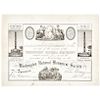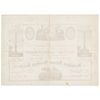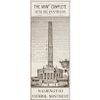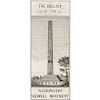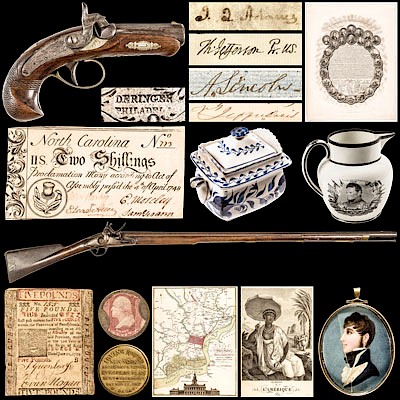c. 1850 Historic $1 Contribution To Building of The Washington National Monument
Lot 202
Categories
Estimate:
$500 - $700
Absentee vs Live bid
Two ways to bid:
- Leave a max absentee bid and the platform will bid on your behalf up to your maximum bid during the live auction.
- Bid live during the auction and your bids will be submitted real-time to the auctioneer.
Bid Increments
| Price | Bid Increment |
|---|---|
| $0 | $10 |
| $200 | $20 |
| $300 | $25 |
| $500 | $50 |
| $1,000 | $100 |
| $2,000 | $200 |
| $3,000 | $250 |
| $5,000 | $500 |
| $10,000 | $1,000 |
| $20,000 | $2,000 |
| $30,000 | $2,500 |
| $50,000 | $5,000 |
| $100,000 | $10,000 |
| $200,000 | $20,000 |
| $300,000 | $25,000 |
| $500,000 | $50,000 |
About Auction
By Early American History Auctions
Oct 19, 2019
Set Reminder
2019-10-19 12:00:00
2019-10-19 12:00:00
America/New_York
Bidsquare
Bidsquare : Historic Autographs-Currency-Political-Americana-Militaria-Guns
https://www.bidsquare.com/auctions/early-american-history-auctions/historic-autographs-currency-political-americana-militaria-guns-4513
326 Lots of Rare, Historic Autographs, Americana, Civil War Era, George Washington, Abraham Lincoln, Black History, Revolutionary War Era, Colonial America, Federal Period, War of 1812, Colonial Currency, Indian Peace Medals & more... Early American History Auctions auctions@earlyamerican.com
326 Lots of Rare, Historic Autographs, Americana, Civil War Era, George Washington, Abraham Lincoln, Black History, Revolutionary War Era, Colonial America, Federal Period, War of 1812, Colonial Currency, Indian Peace Medals & more... Early American History Auctions auctions@earlyamerican.com
- Lot Description
Washington Related
Building Of The "Washington Monument" $1 Contribution with Zachary Taylor, Complete & Issued on Rare Blue Paper
c. 1850, Partially-Printed Engraved Membership Certificate, Receipt for a $1 Contribution towards the Construction of the Washington National Monument, Fully Completed and Issued on Rare Blue Paper, (Zachary Taylor) (President), Choice Very Fine.
This original Partially-Printed Engraved Certificate, is acknowledging receipt of a contribution of one dollar to the erection of the National Monument to George Washington, measuring 7.25" x 10", printed in black on a rare color, blue wove period paper. It was issued by the Washington National Monument Society. This certificate bears the engraved Printed signatures of Zachary Taylor (President), Elisha Whittlesey (General Agent), George Watterston (Secretary) and Alesly Head (Agent). The left side shows a vignette of the "Monument Complete with the Pantheon" (which was never built). The right side shows a vignette of the Monument shown as we know it today. Beautifully printed, completed in manuscript, with bold writing. At center, an impressive bust of George Washington faces left. An example offered in our December 9, 2000 sale, Lot 235 on standard white wove paper, sold at $690.00 while another similar sold for $944.00 in our more recent May 16, 2009 Auction, Lot 225 graded Very Fine. This current blue paper example is very clean and highly attractive, the very first we have seen. Beautifully presented and printed on light blue paper making it excellent for display.
The Washington Monument was built between 1848 and 1884 as a memorial to George Washington, first President of the United States. Its construction took place in two major phases, 1848-56, and 1876-84--the Civil War and a lack of funds causing the intermittent hiatus. Plans for a national monument began as early as 1783 when Major Pierre Charles L'Enfant proposed to Congress that an equestrian statue of George Washington be erected.
Although the Monument was authorized by Congress, no action was taken by the time Washington died in 1799. His death rekindled public aspiration for an appropriate memorial to him, and John Marshall proposed that a special sepulcher be erected for the General within the Capitol itself. Lack of funds postponed construction, but Marshall persevered, and in 1833 he and James Madison formed the Washington National Monument Society. By 1836 the Society advertised for competitive architectural designs.
The winning architect was Robert Mills, whose design called for a neoclassical plan which provided for a nearly-flat-topped obelisk surrounded by a circular colonnade on which would stand a statue of Washington in a chariot. Inside the colonnade statues of 30 prominent Revolutionary War heroes would be displayed.
In an elaborate Fourth of July ceremony in 1848, the cornerstone was laid. Lack of funds and the illegal election which placed the Washington Monument Society in the hands of the Know-Nothings, a political party, caused delays. After the Know Nothings returned all records to the original society in 1858, the Civil War interrupted construction.
When Lt.Col.Thomas L.Casey, Mills' successor, resumed the project in 1876, he redesigned the monument to resemble an unadorned Egyptian obelisk with a pointed pyramidion. The original design was greatly altered, producing an unembellished obelisk. The Corps of Engineers of the War Department was placed in charge of the final construction, and the monument was dedicated on February 21, 1885, and opened to the public on October 9, 1888.
- Shipping Info
-
Early American provides in-house worldwide shipping. Please contact us directly if you have questions about your specific shipping requirements.
-
- Buyer's Premium



 EUR
EUR CAD
CAD AUD
AUD GBP
GBP MXN
MXN HKD
HKD CNY
CNY MYR
MYR SEK
SEK SGD
SGD CHF
CHF THB
THB
